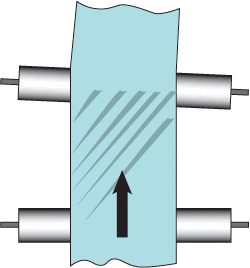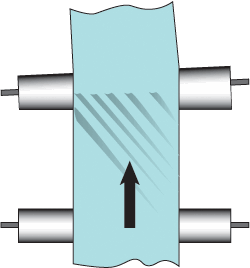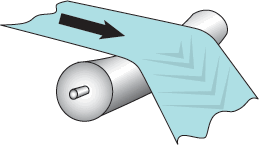[vc_row][vc_column][vc_column_text]An article by Pete Eggen of WebEx inc.
Wrinkles in web handling during converting can come from a variety of sources and sometimes multiple sources. Thus, pinpointing the exact cause and cure is not always easy. In fact, it is often a process of trial and error.
This article addresses seven common causes of web wrinkling along with practical solutions. It should be understood up front that no two webs or web lines run exactly the same. Likewise, no two wrinkling issues are identical. The cure for one may not be the cure for another, no matter how alike.
In addition, the causes of web wrinkling can vary greatly. Nonetheless, armed with a better understanding of some of the common causes and cures can help minimize trial and error efforts to get you back on target with your desired productivity and quality goals. Read below to learn about the top 7 causes of web wrinkling problems in web handling.
1. Poor Machine Alignment
Machine alignment is the first thing to check when experiencing web performance problems (see Figure 1). New rollers may be a waste of money if machine stands are not aligned properly. Though most machines are aligned when first installed, misalignment can develop later due to vibration, improper machine or roller maintenance, tension over time, or in colder climates, even freeze-thaw conditions that can shift plant floors.
Poor alignment between rollers can ultimately cause a wide variety of web problems, including drift, flutter, and wrinkling. Straightening out the slightest misalignment is critical to achieving a higher-quality process.
Though alignment services can be tedious or costly, you may save time and money over other remedies that simply do not work. Checking machine alignment is an essential starting point and a good investment.

Figure 1: Machine misalignment leads to roll misalignment.
2. Poor Roller Geometry
Figure 2). Imagine a racecar whose tires are larger in diameter on one side of the car than the other, so the car turns naturally inward on the oval track. Likewise, the web will “turn” if the roll is bigger on one side than the other. When the web contacts the following roll at an angle, this roll will try to readjust the web back parallel to the roller’s centerline. This generally results in a wrinkle.
Poor roll geometry can come from poor craftsmanship in the design and/or manufacture of the roll, excessive surface wear, or from inadequate roll specifications.

Figure 2: Poor roll geometry can lead to tension differences that cause wrinkling.
3. Poor Web Quality
Poor web quality, such as gauge variation or poorly wound parent rolls,, can cause many web handling problems. Excessive parent roll run-out can translate into vibration and web flutter. Inconsistent or poor-quality web material can end up creating wrinkles in web handling throughout the whole process. No roller can totally cure that.
Most machine operators can tell when they have a bad parent roll on the stand. Don’t accept inferior parent rolls from your upstream supplier. Once again, do not try to treat the symptom but attack the problem at the source.
4. Excessive Roll Deflection
Excessive roll deflection, or bowing of the roll under the force or load of the web, can cause wrinkling (see Figure 3). It may not be the effect of a single roll that causes the problem but the effect of the total system.
Like so many other situations, the extent of the problem will depend greatly upon the web characteristics. Small-diameter idlers with long face lengths should raise a red flag for any roller supplier or machine designer. Roller material (steel, aluminum, or carbon composite), roller diameter, wall thickness, face length, web width, shaft sizing, and bearing location all have to take the load, or deflection, into consideration.
To avoid deflection problems, be sure your rolls are properly specified. When ordering, you should know the amount of web wrap (usually stated in terms such as 10 o’clock to 3 o’clock), web tension (PLI), any nip load (PLI), web width, and maximum expected line speed. A good supplier will walk you through these questions and can even help you troubleshoot much of this over the phone.

Figure 3: Roller deflection from higher web tensions can create tension differences between edges and inside material that can cause sagging centers and/or wrinkles.
5. Web Expansion
Changes in web conditions, such as increased temperature or moisture content, are likely to cause variations in the web material. For example, when a web tries to expand and is constrained by frictional contact with a roller, wrinkles are likely to occur. In these cases, a strategically located spreader roll—one with a special surface grooving—can accommodate the variation and alleviate the tendency of wrinkles in web handling.
6. The Unsupported Web
Too little web support can result in bagging and wrinkling (see Figure 4). Unsupported webs also are susceptible to other environmental factors, such as drafts from nearby equipment or normal plant ventilation. Even an open door can cause enough draft to result in wrinkling.

Figure 4: Unsupported webs are more likely to wrinkle.
Idlers are typically used to provide needed web support. The very act of wrapping a web around a roller does increase the web’s lateral rigidity. The strength and weight of the web will have a lot to do with the number and location of idlers needed. An applications engineer can better troubleshoot your problem when provided an elevation side view indicating rollers and location(s) where wrinkling occurs.
If wrinkling occurs on a longer web span between rollers, additional idler support may be needed. When evaluating web span, consider the width of the web. A rule of thumb is: short = less than the width of your web; long = 3x the width of your web.
7. Improper Web Tension Control
Excessive web tension can wrinkle, stretch, or break the web and cause unwanted roll deflection. Excessive tension can come from too much drag on idler rolls (bearing friction, roll weight, etc.) or from too many idler rolls between drive sections.
Stretched edges and slack centers on the web are common with excessive tension.Loose webs also can result in wrinkles. Lack of sufficient tension can come from drive sections being out of sync or a poorly designed or calibrated tension control system.
Lighter weight rolls may solve tension problems experienced during line speed changes. These idlers can supply support without excessive drag. If the problem persists once the web is up to speed, an idler designed with special free-running bearings may be needed.
If you suspect tension problems are from too many rolls or too heavy rolls, try experimenting. Spin individual idlers by hand. Are they hard to turn? Can you selectively remove or replace some rolls and see if problems can be reduced?
If you are running a light web at light tension, and all your rolls are heavy steel idlers with sealed bearings, you could try lighter-weight idlers with free-running bearings to reduce roll inertia and drag. Lighter materials like aluminum or carbon fiber with free-running bearings can significantly change operating performance.
Regardless of the many precautions and cures you might apply to your web converting operation, sometimes wrinkling will just happen. In some instances, a special roller will help. In others, it won’t. The problem may be in how the parent roll was wound. It might be in the makeup of the material itself. The cause may be a combination of things, some of which may be out of your control.
There is no magic cure for wrinkles in web handling. Do your homework and then look to the experience and advice of a qualified roller manufacturer to help work through the options. Contact Sure Controls today for any web handling questions.
[/vc_column_text][/vc_column][/vc_row][vc_row h2=”” use_custom_fonts_h2=”” h2_font_container=”tag:h2|text_align:left” h2_use_theme_fonts=”” h2_google_fonts=”font_family:Abril%20Fatface%3Aregular|font_style:400%20regular%3A400%3Anormal” h2_css_animation=”” h4=”” use_custom_fonts_h4=”” h4_font_container=”tag:h4|text_align:left” h4_use_theme_fonts=”” h4_google_fonts=”font_family:Abril%20Fatface%3Aregular|font_style:400%20regular%3A400%3Anormal” h4_css_animation=”” txt_align=”left” shape=”square” style=”classic” color=”black” el_width=”” add_button=”bottom” btn_title=”SHOP PARTS” btn_style=”custom” btn_gradient_color_1=”turquoise” btn_gradient_color_2=”blue” btn_gradient_custom_color_1=”#dd3333″ btn_gradient_custom_color_2=”#eeee22″ btn_gradient_text_color=”#ffffff” btn_custom_background=”#d1394b” btn_custom_text=”#ffffff” btn_outline_custom_color=”#666″ btn_outline_custom_hover_background=”#666″ btn_outline_custom_hover_text=”#fff” btn_shape=”round” btn_color=”grey” btn_size=”md” btn_align=”center” btn_button_block=”” btn_add_icon=”” btn_i_align=”left” btn_i_type=”fontawesome” btn_i_icon_fontawesome=”fas fa-adjust” btn_i_icon_openiconic=”vc-oi vc-oi-dial” btn_i_icon_typicons=”typcn typcn-adjust-brightness” btn_i_icon_entypo=”entypo-icon entypo-icon-note” btn_i_icon_linecons=”vc_li vc_li-heart” btn_i_icon_monosocial=”vc-mono vc-mono-fivehundredpx” btn_i_icon_material=”vc-material vc-material-cake” btn_i_icon_pixelicons=”vc_pixel_icon vc_pixel_icon-alert” btn_css_animation=”” btn_custom_onclick=”” add_icon=”” i_on_border=”” i_type=”fontawesome” i_icon_fontawesome=”fas fa-adjust” i_icon_openiconic=”vc-oi vc-oi-dial” i_icon_typicons=”typcn typcn-adjust-brightness” i_icon_entypo=”entypo-icon entypo-icon-note” i_icon_linecons=”vc_li vc_li-heart” i_icon_monosocial=”vc-mono vc-mono-fivehundredpx” i_icon_material=”vc-material vc-material-cake” i_color=”blue” i_background_style=”” i_background_color=”grey” i_size=”md” i_css_animation=”” css=”.vc_custom_1668649390488{background-color: #ffffff !important;}” btn_link=”url:https%3A%2F%2Fwww.surecontrols-store.com%2F|target:_blank” h2_link=”” h2_el_id=”” h2_el_class=”” h4_link=”” h4_el_id=”” h4_el_class=”” custom_background=”” custom_text=”” btn_el_id=”” btn_el_class=”” btn_custom_onclick_code=”” i_custom_color=”” i_custom_background_color=”” i_link=”” i_el_id=”” i_el_class=””][vc_column][vc_cta h2=”” shape=”square” color=”black” add_button=”bottom” btn_title=”SHOP PARTS” btn_style=”custom” btn_custom_background=”#d1394b” btn_custom_text=”#ffffff” btn_shape=”round” btn_align=”center” css=”.vc_custom_1668649383624{background-color: #000000 !important;}” btn_link=”url:https%3A%2F%2Fwww.surecontrols-store.com%2F|target:_blank”]
Looking For Industrial Automation Parts? We Can Help!
[/vc_cta][/vc_column][/vc_row][vc_row][vc_column][vc_raw_html]JTNDc2NyaXB0JTIwdHlwZSUzRCUyMmFwcGxpY2F0aW9uJTJGbGQlMkJqc29uJTIyJTNFJTBBJTdCJTBBJTIwJTIwJTIyJTQwY29udGV4dCUyMiUzQSUyMCUyMmh0dHBzJTNBJTJGJTJGc2NoZW1hLm9yZyUyMiUyQyUwQSUyMCUyMCUyMiU0MHR5cGUlMjIlM0ElMjAlMjJCbG9nUG9zdGluZyUyMiUyQyUwQSUyMCUyMCUyMm1haW5FbnRpdHlPZlBhZ2UlMjIlM0ElMjAlN0IlMEElMjAlMjAlMjAlMjAlMjIlNDB0eXBlJTIyJTNBJTIwJTIyV2ViUGFnZSUyMiUyQyUwQSUyMCUyMCUyMCUyMCUyMiU0MGlkJTIyJTNBJTIwJTIyaHR0cHMlM0ElMkYlMkZ3d3cuc3VyZWNvbnRyb2xzLmNvbSUyRiUyRnRvcC03LWNhdXNlcy1vZi13cmlua2xlcy1pbi13ZWItaGFuZGxpbmclMkYlMjIlMEElMjAlMjAlN0QlMkMlMEElMjAlMjAlMjJoZWFkbGluZSUyMiUzQSUyMCUyMldyaW5rbGVzJTIwaW4lMjBXZWIlMjBIYW5kbGluZyUyMCVFMiU4MCU5MyUyMFRvcCUyMDclMjBDYXVzZXMlMjIlMkMlMEElMjAlMjAlMjJkZXNjcmlwdGlvbiUyMiUzQSUyMCUyMlRoaXMlMjBibG9nJTIwcG9zdCUyMGRpc2N1c3NlcyUyMHRoZSUyMHRvcCUyMDclMjBjYXVzZXMlMjBvZiUyMHdyaW5rbGVzJTIwaW4lMjB3ZWIlMjBoYW5kbGluZy4lMjBUaGUlMjB0b3AlMjA3JTIwY2F1c2VzJTIwb2YlMjB3cmlua2xlcyUyMGluJTIwd2ViJTIwaGFuZGxpbmclMjBpbmNsdWRlJTIwcG9vciUyMG1hY2hpbmUlMjBhbGlnbm1lbnQlMkMlMjBwb29yJTIwcm9sbGVyJTIwZ2VvbWV0cnklMkMlMjBwb29yJTIwd2ViJTIwcXVhbGl0eSUyQyUyMGV4Y2Vzc2l2ZSUyMHJvbGwlMjBkZWZsZWN0aW9uJTJDJTIwd2ViJTIwZXhwYW5zaW9uJTJDJTIwdGhlJTIwdW5zdXBwb3J0ZWQlMjB3ZWIlMkMlMjBhbmQlMjBpbXByb3BlciUyMHdlYiUyMHRlbnNpb24lMjBjb250cm9sLiUyMiUyQyUwQSUyMCUyMCUyMmltYWdlJTIyJTNBJTIwJTIyaHR0cHMlM0ElMkYlMkZ3d3cucGZmYy1vbmxpbmUuY29tJTJGaW1hZ2VzJTJGd2ViX2hhbmRsaW5nJTJGV3JpbmtsZUFydDEuZ2lmJTIyJTJDJTIwJTIwJTBBJTIwJTIwJTIyYXV0aG9yJTIyJTNBJTIwJTdCJTBBJTIwJTIwJTIwJTIwJTIyJTQwdHlwZSUyMiUzQSUyMCUyMk9yZ2FuaXphdGlvbiUyMiUyQyUwQSUyMCUyMCUyMCUyMCUyMm5hbWUlMjIlM0ElMjAlMjJTdXJlJTIwQ29udHJvbHMlMjIlMkMlMEElMjAlMjAlMjAlMjAlMjJ1cmwlMjIlM0ElMjAlMjJodHRwcyUzQSUyRiUyRnd3dy5zdXJlY29udHJvbHMuY29tJTJGJTIyJTBBJTIwJTIwJTdEJTJDJTIwJTIwJTBBJTIwJTIwJTIycHVibGlzaGVyJTIyJTNBJTIwJTdCJTBBJTIwJTIwJTIwJTIwJTIyJTQwdHlwZSUyMiUzQSUyMCUyMk9yZ2FuaXphdGlvbiUyMiUyQyUwQSUyMCUyMCUyMCUyMCUyMm5hbWUlMjIlM0ElMjAlMjJTdXJlJTIwQ29udHJvbHMlMjIlMkMlMEElMjAlMjAlMjAlMjAlMjJsb2dvJTIyJTNBJTIwJTdCJTBBJTIwJTIwJTIwJTIwJTIwJTIwJTIyJTQwdHlwZSUyMiUzQSUyMCUyMkltYWdlT2JqZWN0JTIyJTJDJTBBJTIwJTIwJTIwJTIwJTIwJTIwJTIydXJsJTIyJTNBJTIwJTIyaHR0cHMlM0ElMkYlMkZ3d3cuc3VyZWNvbnRyb2xzLmNvbSUyRndwLWNvbnRlbnQlMkZ1cGxvYWRzJTJGMjAyMCUyRjAzJTJGMTgweDY1X1VQZGF0ZWRTdXJlQ29udHJvbHNfVE0ucG5nJTIyJTBBJTIwJTIwJTIwJTIwJTdEJTBBJTIwJTIwJTdEJTJDJTBBJTIwJTIwJTIyZGF0ZVB1Ymxpc2hlZCUyMiUzQSUyMCUyMjIwMTktMDUtMDQlMjIlMkMlMEElMjAlMjAlMjJkYXRlTW9kaWZpZWQlMjIlM0ElMjAlMjIyMDIyLTExLTE2JTIyJTBBJTdEJTBBJTNDJTJGc2NyaXB0JTNF[/vc_raw_html][/vc_column][/vc_row]
